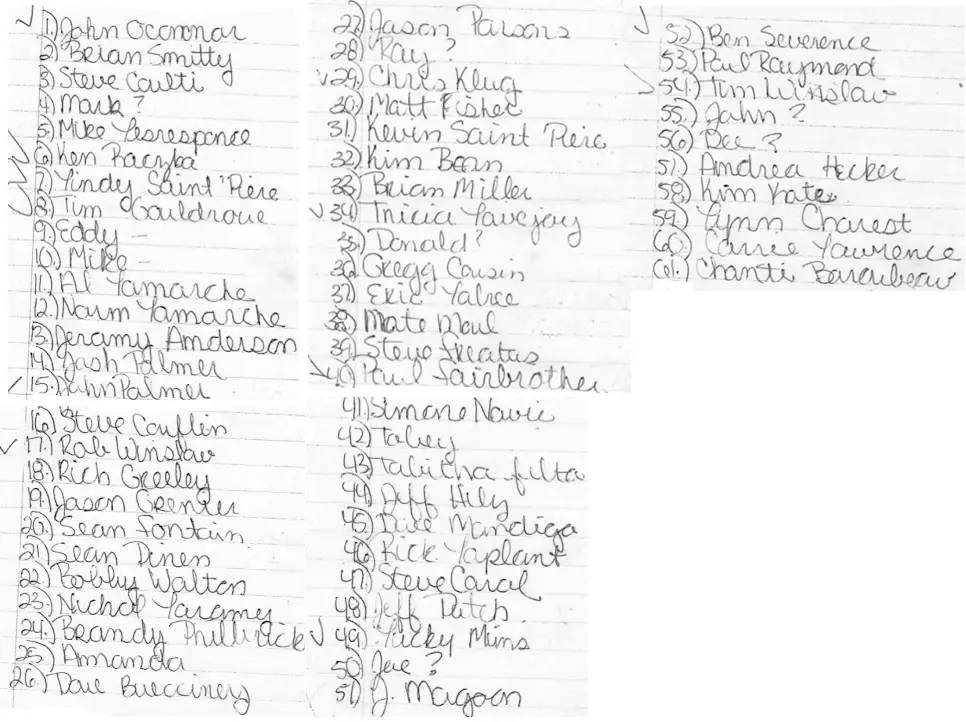Carrie Moss was born to Warren and Sally Moss on March 13, 1975, in New Boston, New Hampshire. She has four siblings – a brother and three sisters. The Moss family resided on Parker Road in New Boston.
Carrie, 14, attended Goffstown Junior High School. Like many teenagers, Carrie became a bit rebellious and ran around with older kids, who likely influenced her into doing things she might not have done before. She even got into trouble, which resulted in house arrest.
Carrie loved writing in journals where she could jot down her thoughts and dreams and keep them hidden from others. She often referred to herself as a “runaway” and longed to be an adult.
In June 1989, local police arrested Carrie for possession of marijuana, which resulted in a court date set for Wednesday, July 26, 1989.
The day before court, Carrie left home to ride her bicycle nearly two miles to Goffstown to go swimming with friends.
Her parents searched for her when she had not returned by the following morning for court. They ultimately went to court in her place to explain to the judge that she did not come home the night before.
Her family assumed she had skipped court due to her previous house arrest and did not want to be on house arrest again. The police believed she had run away. However, there were no family problems, and Carrie did not take any belongings. Regardless, the judge issued a warrant for her arrest.
Meanwhile, the Moss family continued searching for Carrie and had traveled all over Massachusetts, hoping to find her.
School had started that fall for the 1989-1990 academic year, but Carrie had not returned home. Her parents filed a missing person report. Early news reports state that officials had no idea why the parents waited two months to file the report. According to Oak Hill Research, Carrie’s parents had to file twice more over the next two years because the police had removed her from their missing person list.
The family wanted to hire a private investigator, but the police dissuaded them, saying it would hurt the investigation.
In the months following Carrie’s disappearance, several of her friends moved out of the area, causing her family to wonder if they knew something. Meanwhile, the family continued searching.
On April 7, 1990, the body of Sonya Moore, 14, was found in Stark Pond in Dunbarton, about seven miles north of New Boston. Sonya disappeared on Nov. 2, 1989, after leaving home at 36 Summer Street, Penacook (Concord). Her body had been in the water for a significant period and was discovered when winter’s ice melted. According to Sonya’s brief entry on the New Hampshire Department of Justice website, the medical examiner ruled that her death resulted from homicidal violence of an unspecified type.
Carrie’s parents wondered if something similar had happened to their daughter.
On July 18, 1991, almost two years after Carrie’s disappearance, a 10-year-old boy found a nearly complete skeleton in the woods near a remote campsite one to two miles from Carrie’s home and nowhere near any route to Goffstown. Teenagers sometimes partied in the area. It is unclear if the police had found Carrie’s bicycle.
Dental records and a broken leg confirmed the remains as Carrie’s. The state’s chief medical examiner Roger M. Fossum ruled her death a homicide, but he could not determine the cause of death, as in the case of Sonya Moore. Carrie’s remains were later cremated.
Carrie had listed the names of 61 people, both male and female, in her journal. She had put a checkmark next to 12 of them. Her family does not know how close to the time of her disappearance she jotted them down or what the checkmarks signify. I found most of the people with checkmarks and some without on Facebook. Many went to Goffstown schools, so they were likely Carrie’s classmates. But why did Carrie create the list in the first place?
The family has made public appeals over the last few years, but the police never arrested anyone for Carrie’s death.
While Sonya Moore’s case is similar in many ways to Carrie’s and could be connected, her disappearance never received any media coverage that I could find.
Between 1978 and 1991, several young women vanished from New England. Some were found dead; others were never found. The Connecticut River Valley killings took place during this time frame.
Seven young women between 17 and 38 years old were brutally killed by a possible serial killer along Interstate 91 in New Hampshire and Vermont between 1978 and 1988.
Between 1980 and 1984, four girls between 14 and 16 vanished from New Hampshire. One of them, Elizabeth Lamotte, 16, was last seen in Manchester in 1984. Her remains were found in Tenessee in 1985 but not identified until 2017. Manchester is about 16 miles east of New Boston, where Carrie lived.
Between 1985 and 1989, three girls between 14 and 16 and similar in appearance to Carrie vanished from nearby Massachusetts. One of the girls was last seen riding her bicycle about 45 miles southeast of New Boston in Stow, MA.
These cases may not be related to one another or Carrie’s, but they are worth mentioning.
Carrie Moss’s case remains unsolved. If you have any information regarding Carrie’s murder, please submit a tip to the New Hampshire Cold Case Unit.
To read more about Carrie Moss and see family pictures or read about other missing and murdered New England girls, please visit Oak Hill Research.
True Crime Diva’s Thoughts
I wonder if Carrie had lied about going to Goffstown. Instead, she was meeting someone at or near the location of her remains. Maybe she and a few friends secretly made plans to party that day, or she met up with a boy. The area is remote, and teenagers had partied there.
I lied to my parents numerous times so I could go party with friends. We know Carrie had already experimented with marijuana, so I think it’s very likely she could have dabbled in harder stuff and/or alcohol. Maybe she accidentally died, or her killer(s) intentionally lured her to the area.
I find it somewhat interesting that several of her friends relocated within a few months of her disappearance. If they had known something, their parents also did because they relocated. I think Carrie knew her killer, and several people in the New Boston/Goffstown area know what happened to Carrie.
Maybe whoever killed her had help disposing of her body and bicycle. A serial killer might have killed Carrie, although I do not believe it was the CT River Valley killer. Another serial killer might have preyed on teenage girls in New England in the 1980s.
The list of names in her journals is interesting because she has 12 checkmarks next to certain males and females. She had a reason for the marks and the names. But what? Maybe the marks mean the people she usually hung out with or had partied with previously.
I found many on the list on Facebook. Other than school connecting them to Carrie, I have no idea why she listed them in her journal.




